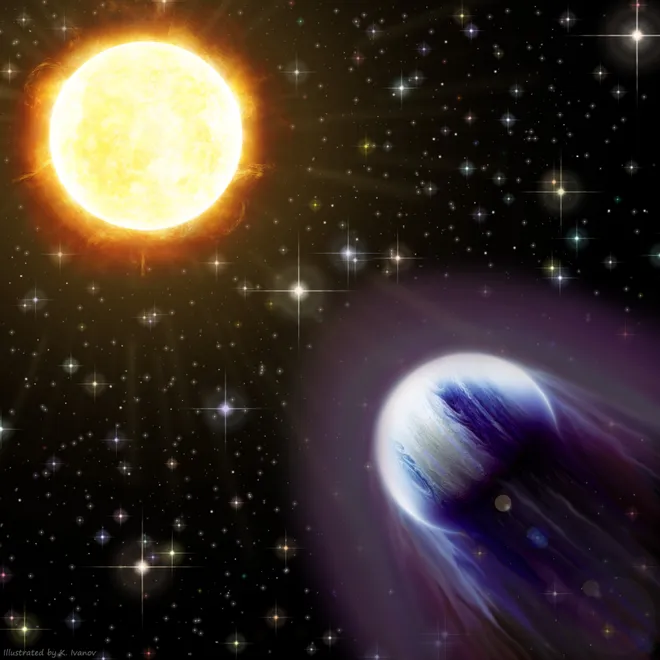Researchers find 'fluffy oddball' of a planet with a composition similar to cotton candy
A strange, fluffy planet has a group of international scientists puzzled - not only because it's larger than the gargantuan Jupiter but because it's also incredibly light.
The celestial body, which scientists called the second lightest planet ever discovered, is so light that researchers are comparing its composition to that of cotton candy.
Dubbed WASP-193b, the planet is not the first to be compared to the classic confectionary staple of amusement parks and state fairs. Another fluffy planet was discovered in 2017, WASP-107b, which is roughly the size of Jupiter with only about 12% of its mass.
But WASP-193b is an enigma all its own, the researchers say.
Located over 1,200 light years from Earth, the "huge, fluffy oddball of a planet" orbits a distant star in our Milky Way galaxy, according to astronomers at the Massachusetts Institute of Technology, who were part of the research published Tuesday in the journal Nature Astronomy.
“The reason why it’s close to cotton candy is because both are pretty much air," study co-author Julien de Wit of MIT said in a statement. "The planet is basically super fluffy.”
'Not done yet:'NOAA detects another solar flare following sun-produced geomagnetic storm
WASP-193b a 'cosmic mystery' among exoplanets

First discovered in 2023, WASP-193b appears to be about 50% bigger than Jupiter, yet is a fraction of its density.
Specifically, the star-orbiting exoplanet outside of our solar system is about seven times less massive than Jupiter, which is why astronomers compare its low density to cotton candy. Only the Neptune-like Kepler-51d, discovered in 2014, is lighter, according to the researchers.
But Kepler-51d is also much smaller than WASP-193b, making the larger planet something of "a cosmic mystery" among the other 5,400 exoplanets discovered so far, study lead author Khalid Barkaoui said in a statement.
“To find these giant objects with such a small density is really, really rare,” said Barkaoui, a postdoctoral researcher at the University of Liège in Belgium. “There’s a class of planets called puffy Jupiters, and it’s been a mystery for 15 years now as to what they are. And this is an extreme case of that class.”
An 'interesting twist' makes determining planet's mass difficult
The exoplanet was spotted by the Wide Angle Search for Planets (WASP), an international collaboration of academic institutions that operates two robotic observatories – one in the northern hemisphere and the other in the south.
Each observatory uses an array of wide-angle cameras to measure the brightness of thousands of individual stars across the sky.
The team of astronomers analyzed data between 2006 and 2012 to determine that it took WASP-193b a little longer than six days to orbit its star. By measuring the amount of light the planet blocked with each transit, they could estimate its size.
The astronomers then looked to pin down the planet’s mass – a measure that would reveal its density and potentially clues to its composition.
However, the team kept coming up empty-handed each time they obtained and analyzed data captured by various ground-based telescopes. Eventually, it was discovered that this was caused by the planet being far too light to have any detectable pull on its star, according to the researchers.
“Typically, big planets are pretty easy to detect because they are usually massive, and lead to a big pull on their star,” de Wit said. “But what was tricky about this planet was, even though it’s big – huge – its mass and density are so low that it was actually very difficult to detect ... It was an interesting twist.”

Could James Webb Space Telescope make more observations?
The team concluded that WASP-193b was likely composed mostly of hydrogen and helium like most other gas giants.
Scientists theorize that the gases could form an inflated atmosphere that extends well beyond Jupiter’s own. How a planet can inflate so much, though, remains a mystery. As of now, no existing theory of planetary formation has an explanation, the astronomers say.
That's why researchers believe that WASP-193b would be an ideal candidate for the James Webb Space Telescope to study further.
"We cannot explain how this planet was formed," Francisco Pozuelos, study author and astronomer at the Instituto de Astrofisica de Andalucia, said in a statement. "Looking more closely at its atmosphere will allow us to constrain an evolutionary path of this planet."
Eric Lagatta covers breaking and trending news for USA TODAY. Reach him at elagatta@gannett.com
Disclaimer: The copyright of this article belongs to the original author. Reposting this article is solely for the purpose of information dissemination and does not constitute any investment advice. If there is any infringement, please contact us immediately. We will make corrections or deletions as necessary. Thank you.






